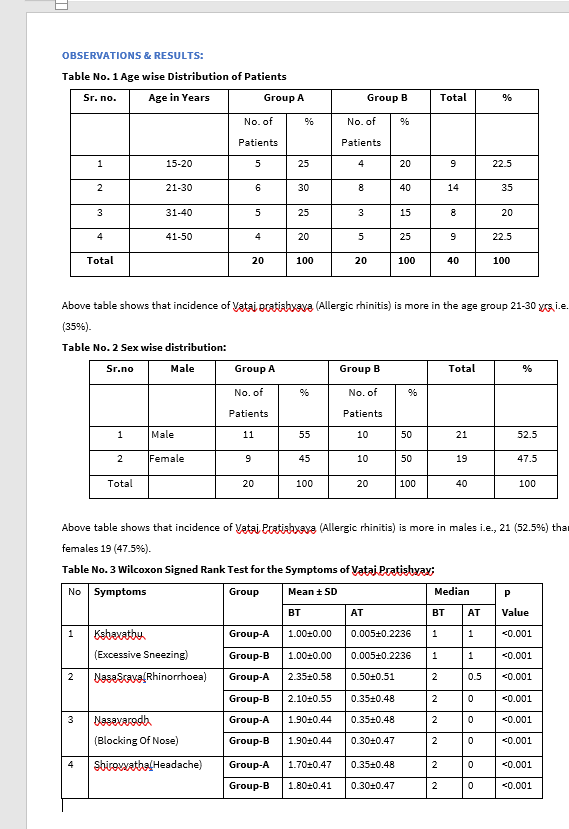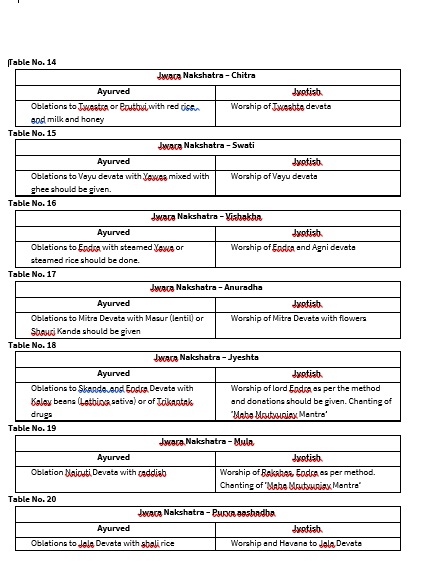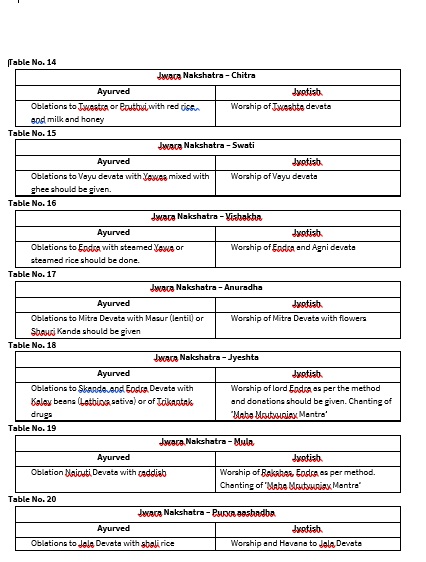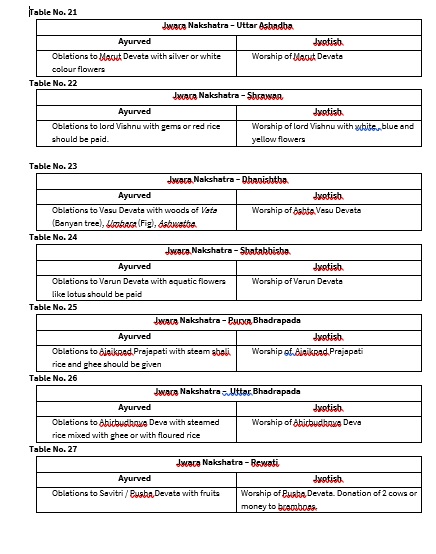Review Article
Year: 2020 |Volume: 1 | Issue: 4 |Pages: 108-117
Critical Comparative Study of Ayurvedic and Jyotishiya Daiva Vyapashraya Chikitsa w.s.r. to Pyrexia of Unknown Origin.
About Author
Correspondence Address:
Dr. Subhash D. Waghe, M.D.(Roga Nidana) HOD – Dept. of Roga Nidana & Vikruti Vigyana Jupiter Ayurvedic College, Nagpur – 441 108 E-mail – carenidan@rediffmail.com (contact no. 7038000648)
Date of Acceptance: 2020-07-15
Date of Publication:2020-08-01
Article-ID:IJIM_17_08_20 http://ijim.co.in
Source of Support: NIL,,
Conflict of Interest: NIL
How To Cite This Article: Waghe S.D, et al. Critical Comparative Study of Ayurvedic and Jyotishiya Daiva Vyapashraya Chikitsa w.s.r. to Pyrexia of Unknown Origin.”. Int. J Ind. Med. 2020;1(4): 108-117.
Abstract
Ayurveda and Jyotish science are not only contemporary of each other but complimentary to each other. Ayurveda had incorporated in itself lot of Jyotishiya concepts right from auspicious timings in various sanskaras to auspicious timings of drug collection and storage. In all these concepts, Nakshatra (constellation) is an important aspect. As per Ayurveda and Jyotisha science, Nakshatra also plays an important role in deciding the prognosis and duration of the disease. It also helps in taking the Daiva Vyapashraya remedial measures as per Nakshatra lord along with the conventional drug treatment. Ayurvedic acharyas are of the view that when diseases does not get cured with conventional measures, one has to think about the sinful bad deeds done by the patient (karma Vipak siddhanta), and the Nakshatra in which the disease took place and accordingly patient has to perform the shantividhana in the form of homa and Havana (offerings in holy fire/oblation), bali (sacrifice), puja (worship) etc as a part of Daiva Vyapashraya chikitsa. In modern medical science also, any fever running for more than two weeks without an apparent cause is labeled as ‘Pyrexia of Unknown Origin’ (PUO). In majority of such cases even after many laboratory investigations, no cause is found and treatment fails. It is concluded that, in pyrexia of unknown origin, the daivavyapashraya treatment could be undertaken as recommended for various constellation derived diseases along with the conventional treatment.
Keywords: Nakshatra, Homa, Puja, Dana, Fever
Introduction
Ayurveda and Jyotish science are not only contemporary of each other but complimentary to each other. Ayurveda had incorporated in itself lot of Jyotishiya concepts right from auspicious timings in various sanskaras to auspicious timings of drug collection and storage. In all these concepts, Nakshatra (constellation) is an important aspect. As per Ayurveda and Jyotisha science, Nakshatra also plays an important role in deciding the prognosis and duration of the disease. It also helps in taking the Daiva Vyapashraya remedial measures as per Nakshatra Adhipati along with the conventional drug treatment. Ayurvedic acharyas are of the view that when diseases does not get cured with conventional measures, one has to think about the sinful bad deeds done by the patient (karma Vipak siddhant), and the Nakshatra in which the disease took place and accordingly patient has to perform the shantividhana in the form of homa and Havana (offerings in holy fire/oblation), bali (sacrifice), puja (worship) etc as a part of Daiva Vyapashraya chikitsa. Particularly acharya Harita, acharya Shaunak, acharya Gautama, acharya Kaushik have mentioned about role of Nakshatra in deciding the outcome of the disease and its holy remedial measures. Nischalkar the commentator of book ‘Chakradutta’, had quoted the views of said acharyas in this regard. Hemadri, the commentator of book ‘Ashtang Hridaya’ also quoted the views of acharya Shaunaka in this regard. Mostly this is told about the disease ‘Jwara’ (fever) appearing in particular Nakshatra and not responding to the conventional treatment.
In modern medical science also, any fever running for more than two weeks without an appearant cause is labeled as ‘Pyrexia of Unknown Origin’ (PUO). In majority of such cases even after many laboratory investigations, no cause is found. Hence, it becomes essential to apply Ayurvedic concept of Nakshatra Utappana Jwara in such conditions to know the outcome of the fever and the holy remedial measures to be taken apart from conventional treatment.
MATERIAL & METHOD
Literary method of research was adopted in the present study. Critical and comparative study of of Ayurvedic literature and Jyotish science literature was done to come to logical conclusion.
REVIEW OF LITERATURE
As per acharya Sushruta, the constellation induced diseases aggravates and gives pain as per the timings of respective constellations.[1]
As per acharya Sushruta, the exogenous fever is due to inhalation of toxic perfumes of drugs and toxic flowers, due to mental grief, curse, mental illness and due to constellation (Nakshatra) induced disease.[2]
As per acharya Vagbhata, the fever developed in Janma Nakshatra (Birth constellation) leads to lot of sufferings and even death.[3]
In the Jyotish literature, following measures have been told to adopt as per constellations for pacifying Nakshtra derived fevers as a part of Daivavyapasharaya Chikitsa which mainly includes oblations (homa) and worship (puja).[4]
For treating these Nakshatra derived fevers , ancient acharyas have advocated to employ ‘Daiva Vyapashraya Chikitsa’ which constitutes following therapeutic measures.[5][6][7]
- Mantra (Religious Chanting)
- Aushadhi (Drugs)
- Mani (Gem stones)
- Mangal (Auspicious measures)
- Bali (Animal sacrifice)
- Uphar (Gifts)
- Homa (Oblations)
- Niyam (Spiritual Regulations)
- Prayaschitta (Atonement)
- Upawas (Fasting and Noble conduct)
- Swasti Wachan (Wellbeing Prayer)
- Pranipat (Bowing and worship to elders, Gurus, Devas)
- Tirtha Gaman (Pilgrimage)
- Dana (Donations)
If the disease has occurred in‘Ashwini’ constellation then pacification of lord Ashwinikumaras is done.As per Ayurveda, for the pacification of Ashwinikumaras, ‘Shiri Vruksha Samidha’ (woods of milk exudating trees) should be offered.Jotish science also holds the same view.
If the disease has occurred in‘Bharani’ constellation then pacification of lord Yama is done.As per Ayurveda, for the pacification of Yama, ‘Tandul’ (rice) should be offered for hawana (oblation) . As per jyotish science, Yama should be worshipped with black flowers if the fever is developed in Bharani Nakshatra. As per Ayurveda, for the pacification of Agni, ‘Dadhi’ (curd) should be offered for hawana if disease is occurred in ‘Krutika’ constellation (Nakshatra). As per Vangasena, ghee should be offered in oblation. As per jyotish science, red garland and oblation should be offered to Agni if disease occurs in Krutika constellation. If the disease has occurred in‘Rohini’ constellation then pacification of lord Surya is done.As per Ayurveda, for the pacification of Surya, ‘Sarva Beej’ (all seed) should be offered for hawana. As per jyotish science, worship and sacrifice should be offered. If the disease has occurred in‘Mrigshira’ constellation then pacification of lord Chandra is done.For the pacification of Chandra, the honey and milk should be offeredin hawana. As per jyotish science, lord Chandra (moon) should be worshipped with white flowers. If the disease has occurred in‘Ardra’ constellation then pacification of lord Shiva is done.As per Aurveda, for the pacification of Rudra, ‘Madhu’ (honey) should be offered for hawana.As per jyotish science, worship of lord Shiva with lotus flowers should be done. Donations and Shantividhan should be done.If the disease has occurred in‘Punarwasu’ constellation then pacification of godess Aditi is done.As per Aurveda, for the pacification of Matruka/ Aditi, ‘Tandul’ (rice) should be offered for hawana.As per jyotish science, worship of godess Aditi should be done. If the disease has occurred in‘Pushya’ constellation then pacification of lord Brihaspati is done.For the pacification of Bruhaspati, ‘Ghrit Payas’ (ghee and milk) should be offered for hawana. As per Jyotish science, worship and donations should be given to the Brahmans in the name of Jupiter to alleviate the fever. Alternatively Jati or Madyanti flower or bath with ghee and milk should be given. If the disease has occurred in‘Aashlesha’ constellation then pacification of lord Sarpa is done.As per Ayurveda, for the pacification of Sarpa, ‘Sarva Aushad’ (all drugs) should be offered for hawana. As per Jyotish science, for the pacification of Sarpa, the 3 cows or money equivalent that should be given. If the disease has occurred in‘Magha’ constellation then pacification of lord Pitrudeva is done.For the pacification of Pitar, ‘Shali Tandul’ (Shali Rice) should be offered for hawana. As per Jyotish science cow should be donated to bramhins or Pitrushanti Puja should be offered go ancestors. If the disease has occurred in‘Purvafalguni’ constellation then pacification of lord Bhaga/Pusha is done.For the pacification of Bhaga, ‘Kamu’ should be offered for hawana. As per jyotish science, shanty puja and cow donation should be given and worship of lord ‘Pusha’ should be performed. For the pacification of Aryama/Rakshasi, ‘Akshat’ (rice) should be offered for hawana if disease is occurred in ‘Uttarafalguni’ constellation. As per Vangasena ghee (ghrita) should be offered for hawana. As per jyotish science, oblation of curd and rice along with donations and worship should be offered. For the pacification of Kratu, ‘Ghrita’ (ghee) should be offered for hawana if disease is occurred in ‘Hasta’ constellation. As per Vangasena, red flowers should be offered in oblation. As per jyotish science, it is due to Ravi dosha and worship of God sun with flowers, perfume, light etc.should be done.
If the disease has occurred in‘Chitra’ constellation then pacification of lord Twashtrais done.For the pacification ofTwashtra, ‘Madhu Payas’ (honey and milk) should be offered for hawana. If the disease has occurred in‘Vayu’ constellation then pacification of lord Swatiis done. For the pacification of Vayu, ‘Grita’ (ghee) should be offered for hawana. As per jyotish science, this disease is due to Vayu dosha and is fatal. If the disease has occurred in‘Vishakha’ constellation then pacification of lord Endrakshiis done.For the pacification of Endrakshi, ‘Yawa Audan’ (cooked Barley) should be offered for hawana.As per jyotish science, worship of Endragni should be done. If the disease has occurred in‘Anuradha’ constellation then pacification of lord Mitrais done.For the pacification of Mitra, ‘Masur’(lentil) should be offered for hawana. As per jyotish science, worship of Mitra deva should be done. For the pacification of Skanda/Kartikeya, ‘Kalay’(lathrys sativa) should be offered for hawanaif disease has occurred in ‘Jyeshtha’ constellation. As per acharya Vangasena, gold should be offered for oblation. In absence of that, yellow flowers should be offered for hawana. As per jyotish science, rice should be offered for oblation, Endrasukta should be chanted, Mrutyunjay mantra should be enchanted. Worship of lord Endra should be done. For the pacification of Nirukti, ‘Mulak’(raddish) should be offered for hawana if disease has occurred in ‘Mula’ constellation. As per acharya Vangasena, Tila (sesame) or Vrihi grains should be offered for oblation. As per jyotish science, worship of Nirukti deva with white rice should be done. Mahamrutyunjay mantra should be chanted. For the pacification of Aap, ‘Shali’(rice) should be offered for hawana if disease is occurred in ‘Purva Ashadha’ constellation. As per acharya Vangasena, ghee and boiled rice should be offered for oblation. As per jyotish science, worship and oblations should be done. If the disease has occurred in‘Uttar Ashadha’’ constellation then pacification of lord Marut is done.For the pacification of Marut, ‘Rajat’(silver) or in absence of that flowers of that colour should be offered for hawana.For the pacification of Vishnu, ‘Sarva Ratna’ (all gems) or in absence of that Tandul (rice) should be offered for hawana if disease is occurred in ‘Shravan’ constellation.As per acharya Vangasena the beans of Murva/Avartani (Helicteres isora) or in absence of that rice should be offered in oblation.As per jyotish science, worship of lord Vishnu with Piatambara, yellow flowers should be done. If the disease has occurred in‘Dhanishtha’ constellation then pacification of lord Vayuis done.For the pacification of Vayu, Vata Shunga should be offered for oblation.If the disease has occurred in ‘Shatabhisha’ constellation then pacification of lord Varuna is done.For the pacification of Varuna , the water flowers like lotus etc should be offered for hawana. As per Jyotish science, the worship of lord ‘Varuna’ should be doneif the disease had occurred in ‘Shatabhisha’ Nakshatra.If the disease has occurred in‘Purva Bhadrapada’’ constellation then pacification of lord Ajaikpada is done.For the pacification of Ajaikpada, ‘Shali Audan’ (cooked rice) should be offered for hawana.If the disease has occurred in‘Uttar Bhadrapada’ constellation then pacification of lord Ahirbudhnyais done.For the pacification of Ahirbudhnya, Ghrit Audan’ (ghee mixed cooked rice) should be offered for hawana. As per jyotish science, the disease in Uttar Bhadrapada are due anger of God. If the disease has occurred in‘Revati’ constellation then pacification of lord Savitri/Pusha is done.As per Ayurveda, for the pacification of Savitri /Pusha, ‘Fala and Akshat’ (fruit and rice) should be offered for hawan. As per Jyotish science, two cows or equivalent amount of money should be donated to te Brahmins if the disease had occurred in ‘Revati’ Nakshatra.[7][8][9][10][11] [12]
OBSERVATIONS

table no. 1-7

table no. 8-13

table 14-20

table 21-27
Discussion
As per Ayurveda, when all other measures fails in the conventional treatment of the disease the physician should suggest the Daivavyapashraya Chikitsa which includes various measures like worship, chanting of prayers (Swastivachan), sacrifices (Bali), penace (Prayaschitta), donations (Dana) and oblations (Homa) of various things to the gods. The Gods ruling the various Nakshatras are different. Hence, oblations are fixed as per the Nakshatra in which the serious disease is occurring and as per the master ruling that particular Nakshatra. Nakshatra is a Jyotishiya concept implemented in Ayurveda. As the ancient Ayurvedic acharyas were also well versed in Jyotish as well as Dharmashastra, they have given the detail account of ‘Shanti Vidhana’ for the serious incurable diseases occurring in various Nakshatras. Particularly the Ayurvedic acharyas like Harita, Shaunka and Kaushika have written Ayurvedic as well as Jyotish and Dharmashastra related Smruti granthas. And the detail account of ‘Shanti Vidhan’ is mainly seen in their granthas. The 15th century author Vangasena had also given the account of ‘Shanit Vidhana’ as part of Daivavyapashraya Chikitsa in his treatise ‘Vangasena Samhita’ in the Jwara chapter. Review of literature, had made clear the Nakshatra lords and measures pacifying them. Jyotishsahastra had given the account of donations and worship for pacifying the particular Nakshatra lord to alleviate the disease whereas Ayurvedic acharyas have given the account of oblations of particular things related with those Nakshatra deities. To find the logic behind these pacifying measures and alleviation of diseases, is a matter of research under controlled conditions.
Conclusion
- There is marked similarity in approach to Daivavyapashraya Chikitsa between Ayurvedic and Jyotish science.
- Mainly the homa (oblation) measure is mentioned by Ayurvedic acharyas like Harit, Shaunak and Kaushik for alleviation of constellation derived fevers.
- Jyotish science had advocated the use of worship and donations along with oblations for alleviation of constellation derived fevers.
- The constellation derived fevers mentioned in Ayurvedic medical science may be due to idiopathic microbial infections.
- In pyrexia of unknown origin, the Daiva-vyapashraya treatment could be undertaken as recommended for various Nakshatras along with the conventional treatment.
References
value="
- Dr. Anantram Sharma,’Sushrut Samhita’of acharya Sushruta, sutrasthana 28/6, edited and translated in hindi by Atrideva, 5th edition,Vol.1, published by Chaukhamba Surbharati Publication, Gopal Mandir lane,Varanasi-221001, 2017, pg. 234
- Dr. Anantram Sharma,’Sushrut Samhita’of acharya Sushruta, Uttartantra 39/21, edited and translated in hindi by Atrideva, 5th edition,Vol.1, published by Chaukhamba Surbharati Publication, Gopal Mandir lane,Varanasi-221001, 2017, pg.244
- Vd. Lalchandshastri, ‘Ashtangsangraha’ of acharya Vagbhata, Nidansthana 1/23 , hindi translation, 2nd edition , published by Shree Baidynath Ayurved Bhavan ltd, Nagpur-440009, 1989, pg. 308
- Acharya Vidyadhar Shukla, Ravidutta Tripathi, ‘Charak samhita’ of acharya Charak and agnivesha, Vimansthana 8/87 , hindi translation, 1st edition, Vol. 1, published by Chaukhamba Sanskrit Pratishthan, 4360/4, ansari road, Daryaganj, New Delhi – 110 002, 2019, pg. 639
- Prof. Sadanand Shukla , ‘Brihat Samhita’ of acharya Varaha Mihira, 98/4-5, hindi translation, 1st edition, Vol.2, Published by Bhartiya Vidya Sansthan, C 27/65, Jagatganj, Varanasi-221002, 2019, pg. 553
- Acharya Vidyadhar Shukla, Ravidutta Tripathi, ‘Charak samhita’ of acharya Charak and agnivesha, Chikitsasthana 3/318 , hindi translation, 1st edition, Vol. 1, published by Chaukhamba Sanskrit Pratishthan, 4360/4, ansari road, Daryaganj, New Delhi – 110 002, 2019, pg. 115
- Vd. Lalchandshastri, ‘Ashtangsangraha’ of acharya Vagbhata, Nidansthana 1/22-32 , hindi translation, 2nd edition , published by Shree Baidynath Ayurved Bhavan ltd, Nagpur-440009, 1989, pg. 308-309
- Acharya Priyavrata Sharma, ‘Chakradutta’ of acharya Chakrapani Dutta, with ‘Ratnaprabha’ Sanskrit commentary by acharya Nischalkara,5/142-146, first edition, published by Swami Jay Ramdas Ramprakash Trust, jaipur – 3022003, 1993, pg.115
- Pandit Hariprasad Tripathi, ‘Vangasena Samhita’ of Vangasena, 2/684-701, hindi translation, 2nd edition, reprint, published by Chaukhamba Sanskrit Series, K 37/117, Gopal Mandir Lane, Varanasi – 221 001, 2016, pg.75-77
- Dr. Subhash Waghe, ‘An Insight To Harit Samhita’,chikitsasthana, Chitrak Kalpa, hindi and English translation, first edition, published by Rashtra Gauvrav Publications, Nagpur – 440018,2017, pg.15-21
- Pt. Padnabh Sharma, ‘Brihat Parashar Horashastra’ of acharya Parashara, panchamabhut faladhyay 95/8-9, hindi translation, 1st edition published by Chaukhamba Surbharati Prakshan, Varanasi -221 001, 2018, pg. 652-653
- Abhay Katyayan, ‘Nakshatra Chikitsa Jyotisham’ chapters 1-41,1st edition, hindi translation, published by Chaukhamba Surbharati Prakashan, K 37/117, Gopal Mandir Lane, Varanasi – 221 001, 2010, pg. 3-70
- Dr. Satyendra Mishra, ‘Narpati Jayacharya’ of Narapati Daivagya, 5/311 , 1st edition, reprint with Sanskrit ‘Jayalakshmi’ commentary and hindi commentary ‘Pragya Vardhini’, Published by Chaukhamba Surbharati Prakashan, K 37/117, Gopal Mandir Lane, Varanasi – 221 001, 2011, pg. 400
"

